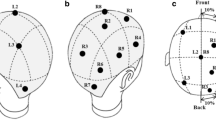Summary
Variations in the electric resistance of the skin (ESR) in relation to sweating were investigated in summer, autumn, and winter. A vacuum-tube voltmeter was used for measurements of ohm-resistance between two silver electrodes which were attached to the skin surface close together, with conductive paste. Concentration of saline solution contained in conductive paste was found to be an important factor affecting the mode of variations in ESR with changes in the rate of sweating. The most significant phenomenon we observed was that, in a hot environment, ESR on areas other than the palm of the hand decreased with depression of sweating only when measured with conductive paste containing saline solution of a high concentration. ESR on the palm, or that on any are of the body surface measured with conductive paste containing saline solution of a low concentration, increased with depression of sweating and decreased with enhancement of sweating. The effect of the season and that of a hot bath on ESR were observed. Possible mechanisms involved in variations of ESR are discussed.
Zusammenfassung
Die Änderungen des elektrischen Widerstandes der Haut (ESR) im Verhältnis zu der Schweißsekretion wurden im Sommer, Herbst und Winter untersucht. Durch das Röhrenvoltmeter wurde der ohmische Widerstand zwischen 2 Silberelektroden gemessen, die auf die Haut mittels einer NaCl-haltigen Kontaktpaste in kleinem Abstand voneinander geheftet wurden. Wiederholte Versuche ergaben, daß die NaCl Konzentration in der Paste ein wichtiger Faktor für die Widerstandsänderungen bei der Schweißsekretion ist.
Das auffallendste Phänomen war folgendes: Bei hoher Zimmertemperatur war eine Abnahme der Schweißsekretion nur dann mit einer Erniedrigung des ESR aller Areale mit Ausnahme des Handtellers begleitet, wenn der ESR bei hoher NaCl-Konzentration der Kontaktpaste gemessen wurde. Die Messung bei niedriger NaCl-Konzentration ergab sowohl am Handteller als auch an allen anderen Hautstellen eine Erhöhung des ESR bei Abnahme der Schweißsekretion und eine Senkung des ESR bei Zunahme der Schweißsekretion.
Die Wirkung der Jahreszeit und des heißen Bades auf den ESR wurde beobachtet. Der mögliche Mechanismus dieser paradoxen ESR-Änderungen wurde diskutiert.
Résumé
Des variations en résistance électrique de peau (REP) en relation de la suée étaient examinés en été, automne et hiver. Un voltmètre électronique était utilisé pour mesurer résistance électrique de peau. Entre deux électrodes d'argent qui étaient attachés à la surface de peau avec de la pâte saline. La concentration du sel dans ce pâte prend un rôle important au point de vue de mesure de REP. Un des phénomènes les plus importants est que REP dans les domaines sauf les paumes décroît parallélement à la dépression de suée provoquée du refroidissement de l'air ou de l'exercice de pression au peau. Il est nécessaire d'utiliser la pâte en haute concentration de ClNa pour voir ce phénomène. La valeur de REP augmente au cas de la depression de suée et diminue au accroissement, quand on utilise la pâte en haute concentration de ClNa. Au même temp, on peut constater des effects de saison et du bain chaud. Des mécanismes possibles à effectuer des variations ci-dessus étaient discutés.
Similar content being viewed by others
References
Takagi, K., andT. Sakurai, Jap. J. Physiol.1 (1950), 22.
Darrow, C. W., Amer. J. Physiol.88 (1929), 219.
M'Dowell, R. J. S., Quart. J. Exper. Physiol., London,23 (1933), 277.
Suchi, T., Jap. J. Physiol.5 (1955), 75.
Thomas, P. E., andI. M. Korr, Fed. Proc.11 (1952), 162.
Thomas, P. E., andI. M. Korr, J. Appl. Physiol., Wash.,10 (1957), 505.
Wagner, H. N., Arch. Dermat. Syph.65 (1952), 543.
Masui, I., J. Jap. Physiol. Soc.7 (1942), 448.
Rein, H., Zschr. Biol.85 (1926), 195.
Lobitz, W. C., andH. L. Mason, Arch. Dermat. Syph.57 (1948), 907.
Conn, J. W., Arch. Int. Med., Chicago,83 (1949), 416.
Author information
Authors and Affiliations
Additional information
With 6 Figures
Rights and permissions
About this article
Cite this article
Takagi, K., Ogawa, T., Terada, E. et al. Sweating and the electric resistance of the skin. Acta Neurovegetativa 24, 404–412 (1962). https://doi.org/10.1007/BF01233011
Issue Date:
DOI: https://doi.org/10.1007/BF01233011




